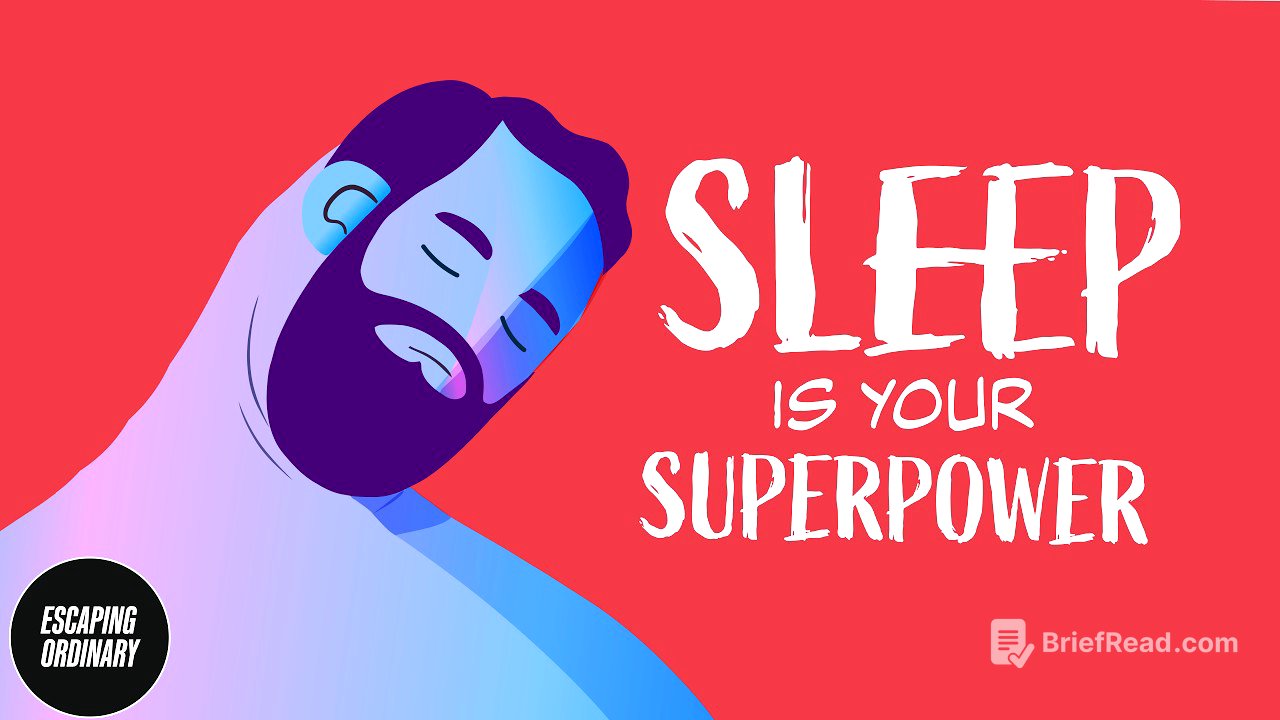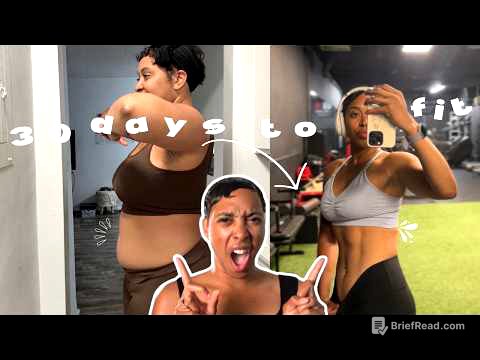TLDR;
This video provides a detailed overview of sleep, its importance, and how to optimize it, drawing inspiration from Matthew Walker's "Why We Sleep." It covers the sleep cycle stages, circadian rhythms, the impact of sleep deprivation, and practical tips for improving sleep quality through diet, timing, light exposure, environment, and personal habits.
- Sleep is essential for brain and body health, affecting memory, creativity, and physical well-being.
- Understanding the sleep cycle and circadian rhythm is crucial for optimizing sleep.
- Practical steps, including diet adjustments, consistent sleep schedules, and managing light exposure, can significantly improve sleep quality.
The Better you sleep the longer you live [0:58]
The video emphasizes the importance of sleep for overall health and longevity. It highlights that understanding the science behind sleep is key to improving sleep quality. The video promises to explore the sleep cycle, circadian rhythms, and provide practical tips for optimizing sleep, inspired by Matthew Walker's book "Why We Sleep."
Part ONE - What is Sleep? [0:58]
Sleep is described as the most effective way to reset the brain and body each day. Quoting Matthew Walker, sleep architecture is Mother Nature's best effort yet at contra-death. The video transitions into a journey through the sleep cycle to familiarize viewers with its stages and components.
A Journey Through the Sleep Cycle [1:15]
The video introduces a detailed exploration of the sleep cycle, guiding viewers through each stage to understand what happens during sleep. It sets the stage for a comprehensive understanding of how sleep works and its importance.
Stage 0 - Awake [1:20]
This stage is the starting point of the sleep journey, representing the transition from wakefulness to sleep. It's the initial phase as one closes their eyes and begins to drift off.
Stage 1 Sleep [1:30]
Stage 1 is the lightest stage of sleep, lasting less than 10 minutes, where one is easily awakened. It's a gentle transition into sleep.
Stage 2 Sleep [1:50]
Stage 2 involves a more subdued state with decreased temperature, relaxed muscles, and slower heart rate. Brain waves show sleep spindles and K complexes, which help decrease sensory inputs and aid memory consolidation. People with more sleep spindles are more resilient to being awakened.
Stage 3 & 4 Sleep [2:28]
Stages 3 and 4 are the deepest stages of sleep, crucial for physical restoration. Brain waves slow down, body tissues heal, the immune system restores, energy is replenished, and growth hormones are released. Waking up during these stages results in disorientation. Insufficient time in these stages leads to physical tiredness, weakened immunity, and decreased cognitive function.
REM Sleep [3:03]
REM (Rapid Eye Movement) sleep is where dreams come alive, marked by high brain activity similar to wakefulness. Dreams are vivid and bizarre, eyes move rapidly, and muscles are paralyzed to prevent acting out dreams. REM sleep is vital for memory consolidation, learning, mood regulation, and creativity.
The Full Cycle [3:45]
The sleep cycle repeats every 90 minutes, with a shift in the balance between deep sleep and REM sleep throughout the night. Deep sleep decreases, and REM sleep increases with each cycle. Most REM sleep occurs in the last few hours before waking up. Reducing sleep time can significantly deprive one of REM sleep, leading to decreased concentration, irritability, mood swings, increased stress, reduced creativity, and problem-solving ability.
The Most Important thing to know about your sleep [3:58]
The dynamic between deep sleep and REM sleep shifts throughout the night, with deep sleep decreasing and REM sleep increasing. Reducing sleep time can significantly deprive you of REM sleep, leading to various cognitive and emotional detriments.
The Circadian Rhythm [5:04]
Two main factors regulate wakefulness and sleep: the circadian rhythm and adenosine. The circadian rhythm dictates rhythmic patterns, including mood, eating preferences, body temperature, and hormone release. It operates on a 24-hour cycle, calibrated by light levels via the suprachiasmatic nucleus (SCN) in the brain. Humans have an internal clock averaging 24 hours and 15 minutes, reset daily by daylight.
How Melatonin works [5:53]
Melatonin, a hormone produced in the brain, regulates sleep and wakefulness. Its release begins at dusk, signaling the body to prepare for sleep, and is halted by dawn sunlight. Daylight is the most reliable resetting signal, but temperature changes and social interactions can also serve this purpose.
Morning Larks VS Night Owls [6:27]
Individual circadian rhythms differ due to genetics, leading to morning larks and night owls. Societal preferences for daytime work can lead to misunderstandings about night owls, who may be misjudged as lazy.
How Adenosine works [6:45]
Adenosine is a key factor in sleep regulation, accumulating while you're awake and resulting in sleep pressure. This pressure decreases during sleep and is purged after 8 hours. Caffeine mitigates adenosine's effects but doesn't prevent its buildup, potentially leading to dependency.
Your WAKE drive VS Your SLEEP drive [7:20]
The circadian rhythm and adenosine work independently, powering the wake drive and sleep drive. Understanding this sleep-wake cycle is crucial for maximizing productivity and maintaining health. Factors like light exposure, caffeine intake, and awareness of individual rhythms significantly affect sleep quality.
Architecture of the Brain for Sleep (7 Parts) [8:00]
Seven brain parts related to sleep are:
- Suprachiasmatic Nucleus (SCN): Controls the circadian rhythm.
- Pineal Gland: Produces melatonin.
- Thalamus: Gatekeeper between wakefulness and sleep.
- Hypothalamus: Contains neurons that control sleep and arousal.
- Pons: Generates REM sleep and regulates breathing, hearing, and taste.
- Medulla: Controls autonomic functions like heart rate and blood pressure.
- Basal Forebrain: Promotes sleep and wakefulness through adenosine release.
Part TWO - Why Should You Sleep? [9:30]
Sleep is essential for memory consolidation, motor task proficiency, and creativity. It acts as a memory aid, refreshing the ability to form new memories and solidifying existing ones.
Memory VS Sleep [9:51]
Sleep plays a vital role in memory consolidation, refreshing the ability to form new memories and solidifying existing ones. The hippocampus acts as a temporary storage, transferring memories to the cortex for long-term storage during sleep.
Motor Tasks VS Sleep [10:37]
Sleep consolidates and strengthens motor tasks, commonly known as muscle memory. It aids the brain in practicing skills and smoothing out wrinkles, making sleep crucial for motor task proficiency.
Creativity VS Sleep [11:06]
Sleep nurtures creativity by associating disparate memories, experiences, and skills, enabling fresh ideas and insights. REM sleep functions as an informational alchemist, merging diverse knowledge stores and facilitating innovative problem-solving abilities.
Sleep Deprivation VS The Brain [11:36]
Lack of sleep impairs focus and concentration, with cognitive function after 9 hours of wakefulness equivalent to that of a legally intoxicated person. Fatigue-related errors cause more traffic incidents than alcohol and drugs combined. Sleep deprivation also affects emotion regulation, memory consolidation, and can inflict lasting damage to DNA and learning-associated genes.
Intermission [13:15]
Short musical break.
Sleep Deprivation VS The Body [13:28]
Sleep deprivation has several negative effects on the body.
Body Part 1 [13:35]
Unhealthy sleep leads to an unhealthy heart, increasing the risk of coronary heart disease, heart attack, and stroke. This results from an overreactive sympathetic nervous system, leading to increased heart rates, blood pressure, and cortisol levels.
Body Part 2 [14:12]
Sleep deprivation detrimentally affects metabolism, contributing to weight gain and increasing the risk of type 2 diabetes. It increases appetite and makes the body less able to manage calorie intake effectively.
Body Part 3 [14:40]
Sleep loss extends to the reproductive system, reducing testosterone levels in men and causing fertility issues in women.
Body Part 4 [15:00]
The immune system relies heavily on sufficient sleep. Lack of sleep can suppress the immune response, reducing natural killer cells and increasing the risk of developing cancer.
Body Part 5 [15:23]
Insufficient sleep can alter the activity of genes, increasing those linked to chronic inflammation and cardiovascular disease while decreasing those promoting stable metabolism and optimal immune responses.
Your Brain on Dreams [15:58]
REM sleep is associated with vivid dreaming, with high brain activity resembling wakefulness. Specific brain parts, such as visuospatial regions, motor cortex, hippocampus, and deep emotional centers, are more active during REM sleep. Areas responsible for rational thought and logical decision-making deactivate, contributing to bizarre, emotionally charged dreams.
Dreams as Therapy [16:36]
REM sleep dreaming offers a form of overnight therapy, transforming painful emotional episodes into less emotionally charged memories. During REM sleep, noradrenaline, a stress-related chemical, is absent from the brain, offering an anxiety-free environment to process memories.
Dreams and Facial Expressions [17:05]
Dreams play a vital role in decoding social cues. REM sleep readjusts the brain's emotional calibration, maintaining the precision required to decode others' emotions based on facial expressions accurately. Deprivation of REM sleep results in a decreased ability to correctly interpret facial expressions.
Sleep Disorder 1 [17:56]
Somnambulism, or sleepwalking, is a sleep disorder marked by unconscious movement during sleep, occurring predominantly during the lighter stages of NREM sleep.
Sleep Disorder 2 [18:20]
Insomnia is characterized by difficulties in falling and staying asleep, even with ample time reserved for sleep. Emotional distress and overreactive sympathetic nervous system activities typically trigger insomnia.
Sleep Disorder 3 [18:44]
Narcolepsy is a neurological disorder that hampers the control of sleep and wakefulness, characterized by extreme daytime sleepiness, sleep paralysis, and cataplexy.
Sleep Disorder 4 [19:07]
Fatal familial insomnia is a rare genetic degenerative brain disorder where individuals gradually lose their ability to sleep, leading to significant physical and mental deterioration and death.
What Would Happen if you were continually kept awake? [19:22]
Experiments on rats and dogs show that extreme sleep deprivation leads to septicemia, body mass loss, inability to maintain body temperature, and extensive internal damage.
The Ultimate Guide to Better Sleep (Supercharge your sleep) [19:48]
The video transitions to practical ways to improve sleep, emphasizing that those with sleep disorders should seek professional advice. Sleep optimization is divided into five categories: diet and substances, timing, light levels, environment, and personal habits.
(Category 1) Optimization [20:32]
Avoid large meals and fluids a few hours before sleep to prevent indigestion and frequent urination. Limit fluids 2-3 hours before sleeping. Avoid caffeine at least 8 hours before sleep, and nicotine altogether. While alcohol may promote sleep, it disrupts the sleep cycle, reducing deep and REM sleep.
(Category 2) Optimization [26:07]
Maintain a consistent sleep schedule to enhance the circadian rhythm's efficiency, making it easier to fall asleep and get restful nights. Avoid naps after 3:00 p.m. as they can make it harder to fall asleep at night.
(Category 3) Optimization [27:50]
Get sunlight in the morning to regulate and reset the circadian rhythm, suppressing melatonin production and promoting wakefulness. Minimize artificial blue light from screens after sunset, using apps or software to reduce blue light or wearing blue light-blocking glasses.
(Category 4) Optimization [31:35]
Use the bedroom only for sleeping to create a mental association with sleep. Ensure the room is as dark as possible with blackout curtains or a sleep mask. Have a comfortable bed and pillow, and consider using a weighted blanket. Maintain an optimal temperature of 18.3°C (65°F).
(Category 5) Optimization [35:42]
Get at least 30 minutes of exercise on most days, avoiding exercise 2-3 hours before sleep. Have a pre-sleep ritual to relax before bed, such as reading or taking a hot bath. If you can't sleep, get up and do something relaxing until you feel sleepy. Monitor your sleep using a sleep monitor to track and adjust as needed.
A Small Request [35:22]
If the video was helpful, consider sharing it with someone who might benefit from the information.









